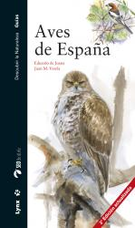 Third Edition - cover
Third Edition - cover 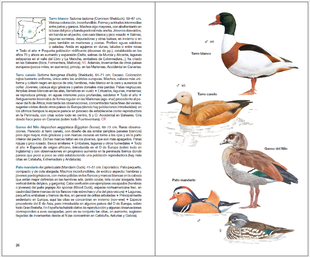 Third Edition - new illustrations of Egyptian Goose & Mandarin
Third Edition - new illustrations of Egyptian Goose & Mandarin 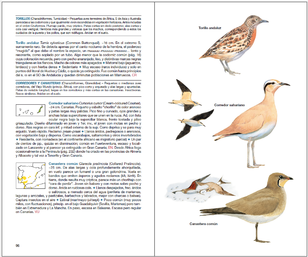 Third Edition - new illustration of "Common Buttonquail'
Third Edition - new illustration of "Common Buttonquail' 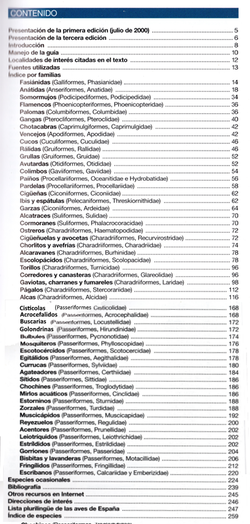 Revised Species List
Revised Species List 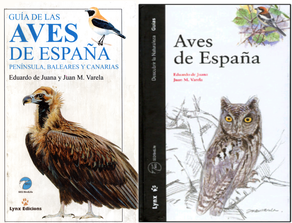 Cover of First (left) & Second Editions (Right)
Cover of First (left) & Second Editions (Right) | Birding Cadiz Province |
|
 Third Edition - cover Third Edition - cover This is the third edition of the “Aves de Espaňa” written by Eduardo de Juana and illustrated by Juan M Varela who, with justification, is often called “Spain's Lars Jonsson”. Given this epithet, it's no surprise to find that the illustrations are superb so good indeed that Lars Jonsson could equally well be called the “Sweden's Juan M Varela”! Originally published in 2000, a second edition with revised text, maps and plates appeared in 2005. This, the latest edition, has continued this process although, with one major exception, it does not seem to have been such a wide ranging up-date. Despite the obvious disadvantage for Anglophones of having texts in Spanish (although all birds are also indexed and labelled with their English names) the maps are far more useful than those given in standard field guides. With basic Spanish you can also get a grasp of distribution and population even if identification details elude you (although see below).  Third Edition - new illustrations of Egyptian Goose & Mandarin Third Edition - new illustrations of Egyptian Goose & Mandarin New illustrations have been provided for a numbers of species (inc. male Capercaillie, Cory's Shearwater, juv Night Heron, winter Kentish Plover, Stonecurlew, Pectoral Sandpiper, Common Buttonquail, Barn, Little, Short-eared and Eagle Owls, Bee-eater, Roller, Great-reed Warbler, Chiffchaff, Dipper, Blackbird, Blue Rockthrush and Snowfinch). Newly illustrated species have been added in the main text (inc. Egyptian Goose, Mandarin, Lesser Flamingo and Red-billed Leiothrix), but surprisingly coverage of Ruppell's Vulture and Pallid Harrier, both increasingly reported, hasn't been significantly enlarged. Bald Ibis and Western Reef Heron have been promoted from the appendix to the main text as have a handful of North African species (originally treated in a section coving the birds found in the Spanish enclave of Cueta. Perhaps significantly Ruddy Duck has been banished altogether and the illustration of Barbary Falcon (now treated as a subspecies of Peregrine has gone AWOL. The general standard of illustrations was already high and these amendments nudge it further towards the Olympian. Oddly, though, one of the very few poor illustrations in the original, that of Marsh Tit, hasn't been replaced. The extensive appendix listing all rarities (and illustrating some) has also been updated rising from 9 to 14 pages.  Third Edition - new illustration of "Common Buttonquail' Third Edition - new illustration of "Common Buttonquail' The text has also been reviewed and updated. Unfortunately, in the process the figures from the most recent Spanish bird atlases (breeding and winter) have been replaced with more general statements. Hence, in the second edition for example, Montagu's Harrier is described as “poco comun ~ 4.000-5.000 pp., quizas en aumento ”, but in the third it reads “Comun (algunos miles de pp) quizeras ultamente en autmento”. Whilst these may be more accurate, they're certainly less obvious to non-Spanish speakers. The same change seems to have been made regarding wintering numbers. It's still fairly easy to work out when the species arrives and departs (if migratory) which is a great help.  Revised Species List Revised Species List The final change is the most far reaching; the familiar order of species has been replaced by the latest scientific version based on DNA research. On result of this is that many original illustrations have been shifted round and often re-sized. Frequently they're now a little smaller, but this has the advantage of making many plates feel less cluttered. If covering wildfowl second, not first, after gamebirds were the only change then it wouldn't be too bad, but many changes militate against the books functionality as a field guide. Grebes are now 20 pages adrift from divers. Nightjars, swifts and cuckoos now find a home just after flamingos but before crakes. Bizarrely Hoopoes, Bee-eaters Roller, Kingfisher and woodpeckers intrude themselves between the larger birds of prey and falcons. Odder still, Hippolais and “wetland warblers” are divided from the 'bush' and 'leaf' warblers by swallows and martins. Meanwhile, Long-tailed Tit is now hiding amongst the warblers! For anyone used to the traditional species order, this is extremely, and unnecessarily, confusing. Advocates for such a change remind us that such changes have happened before and that the new systematics represent a 'biological' reality. This may be so, but previous changes haven't generally divided up groups which have always been lumped together (e.g. raptors) or marooned groups where they instinctively don't seem to belong. Above all a field guide should be practical and these changes certainly make it far more difficult to locate similar groups. It's high time bird guides abandoned a rigorous 'scientific order'. I strongly suspect relatively few users are aware of the reasons behind the order used and would much prefer one based on practicality. The problem has always been agreeing on 'field guide order' that everyone can accept. An Anglo-American team has led the way as far as America is concerned and their scheme could be equally well used in Europe (see https://www.aba.org/birding/v41n6p44.pdf)  Cover of First (left) & Second Editions (Right) Cover of First (left) & Second Editions (Right) I always recommend visitors to Spain to buy a copy of the “Aves de Espaňa” even if their Spanish is, like mine, very limited. I will continue to do so as it remains a convenient reasonably priced one volume source of information. This third edition remains a distinct improvement on the first edition as the maps are more accurate and illustrations improved. But is the third edition an improvement on the second? Despite some useful improvements I'm not so sure. The unfamiliar species order will be welcomed by scientific purists but I doubt that it improves the practicality of the book as a field guide. Hence,even if you have the original version I'd still suggest that you nip out and get the second edition before stocks run out. If you miss out then still get the new edition but be prepared for a degree of frustration! Of course, what's really needed for monoglots like me is an English version. Better still why not add those extra fifty odd species to make it a nice little guide to all regular European birds without all those confusing rarities? It's high the time more British birdwatchers became familiar with the handsome work of “Spain's Lars Jonsson”!
0 Comments
|
About me ...Hi I'm John Cantelo. I've been birding seriously since the 1960s when I met up with some like minded folks (all of us are still birding!) at Taunton's School in Southampton. I have lived in Kent , where I taught History and Sociology, since the late 1970s. In that time I've served on the committees of both my local RSPB group and the county ornithological society (KOS). I have also worked as a part-time field teacher for the RSPB at Dungeness. Having retired I now spend as much time as possible in Alcala de los Gazules in SW Spain. When I'm not birding I edit books for the Crossbill Guides series. CategoriesArchives
May 2023
|